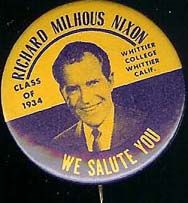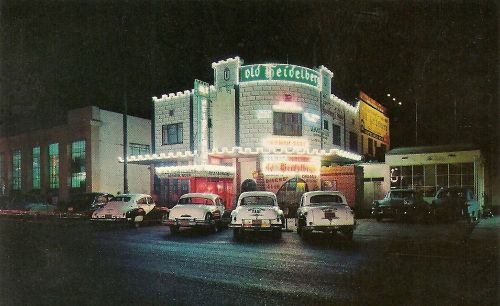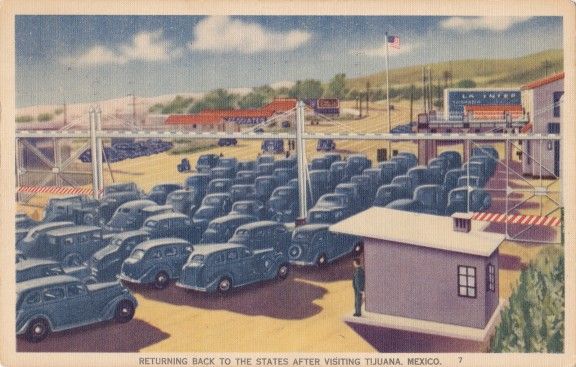WHITTIER - Between waking up, voting and hoping to hear the news that would move him to 1600 Pennsylvania Avenue, Orange County's favorite son took an unexpected and unplanned Southern California road-trip that is an interesting footnote in both politics and Southern California history.
It all began on Election Day 1960 after outgoing Vice President and Republican Presidential hopeful Richard M. Nixon cast his vote at a polling place in Whittier shortly after 8 a.m.

Though it eerily looks a bit like Mitt Romney this is a 1968 cello pin button of Mr. Nixon's being saluted by his alma mater, Whittier College. Artist of this button is unknown.
On the ballot that year as you may know was John F. Kennedy on the Democrat ticket, and Richard M. Nixon on the Republican Ticket.
After voting in Whittier Mr. Nixon and company went over to the Ambassador Hotel in Los Angeles (where years before Richard and Pat Nixon used to go on dates in the hotel's famed Coconut Grove nightclub) to watch the elections results, and where he hoped to give a victory speech, but something funny happened. No, it was not the awkward semi-concession speech Nixon would give that night confusing many reporters and some of the public, because what happened that Election Day 1960 happened before any of the polls closed. Between voting in Whittier and going to the Ambassador Hotel Mr. Nixon decided almost on a whim to ditch the press following him and go on a little quiet road-trip.
Even then, much like today, the press was on every breath and step of the top presidential candidates and if the Republican candidate wanted a random quiet road-trip without the World knowing the first thing Mr. Nixon had to do was lose the press.
So this journey began many blocks from the Whittier polling place when Mr. Nixon and his entourage, which was a military aide and a Secret Service agent, covertly and ever oh-so discreetly away from the press jumped out of the Vice Presidential limo and into a white convertible follow-up car driven by an officer from the Los Angeles Police Department, and off they went, and most importantly, they managed to successfully ditch the press. By the way, Nixon did not just jump into the backseat and say, "let's go," but rather the presidential hopeful told the LAPD officer to scoot over and he, Nixon, drove the car himself.

Then President Nixon standing at a podium at the Anaheim Convention Center in 1970. Photograph courtesy of the Anaheim Public Library archives.
After leaving Whittier and the hounding press behind Mr. Nixon made a visit to his mother in La Habra, and then got on old U.S. 101 and headed south passing Disneyland, Santa Ana, San Clemente (which would later be home to The Western White House) and before long he was soon out of Orange County. In fact, the truth was, Nixon and company had no real idea where they wanted to go.
As the fuel gauge was low Nixon stopped for gas in Oceanside, which, according to Nixon aides, was the only source of relaxation that stressful Tuesday in November. The story goes that Nixon told a gas station attendant, who was, to say the least, a bit surprised to see the Vice President of the United States (and possible new President) out and about on a very important day. Reportedly Nixon told the gas station attendant that, “I’m just out for a little ride.” It was that small exchange at an Oceanside gas station that brought Nixon the only joy that nerve-racking day, according to former Nixon aides.
After leaving Oceanside Mr. Nixon and company continued south on the 101 into San Diego. Well, now in San Diego and not too sure what to do or where to go Nixon mentioned he had not been to Tijuana in over 20 years. Shortly there after the man who might be elected President of the United States by the end of that day was now out of the country and in Tijuana.
Mr. Nixon and company, on advice from a Border Patrol Agent, went to have something to eat at the Old Heidelberg restaurant, which the border agent claimed was the best Mexican food in Tijuana.

The Old Heidelberg restaurant in Tijuana. Date and author of this photograph unknown.
Word got around Tijuana that a possible future U.S. president was in town and soon joining the presidential candidate was Tijuana Mayor Xicotencati Leyva Aleman. It was later reported that Mr. Nixon and everybody in the group ate enchiladas.
After eating enchiladas Mr. Nixon and company headed back for the states, and at the border crossing checkpoint a border agent was shocked to see who was in the car, but still had to ask, "Are you all residents of the United States?" according to Nixon aides.

Painted postcard of the U.S.-Mexican Border in San Diego. Date and artist unknown.
Headed back to L.A. up north on the 101 Mr. Nixon stopped at Mission San Juan Capistrano, which Nixon called “one of my favorite Catholic places.” Surely it was not lost on the Republican presidential hopeful that his Democratic rival was the first Catholic candidate for the President. Years later Nixon said of this visit to the Mission, “For a few minutes, we sat in the empty pews for an interlude of complete escape.”
After that stop in south Orange County it was finally on to the Ambassador Hotel.
As the press and other guests went on over to the Ambassador Hotel and settled in many began to wonder just where is Mr. Nixon? Well, Herb Klein, Nixon’s press secretary, was asked more than a few times about the missing Nixon. Doing what press secretaries do best he smiled at the reporters and told them that Nixon is just taking a private moment with his family as he often does on hectic days. Back in reality Klein had no idea where Nixon was nor that he was out of the country on this very important day.
Mr. Nixon soon showed up at the Ambassador Hotel, and at that moment the press and public were none the wiser that the man who may be elected president in a few hours was earlier in the day a couple hours away in another country.
After a day of randomly driving across Southern California and unexpectedly going to Tijuana, time, as the sun was setting and polls across the country were closing, would soon prove everything.
Mr. Nixon's vote in Whittier that morning was one of many that gave the presidential hopeful California's 32 electoral votes, which however was not enough to win the election as the final electoral college vote was Mr. Kennedy, 303, and out going Vice President Nixon, 219.
Unlike the case and fate of many former vice presidents and presidential candidates Mr. Nixon would not go on to be a historical footnote in history. Rather, time would show that it would not be the last time Mr. Nixon would win California's electoral votes, because in 1968 he won The Golden State's 40 electoral votes, which, at the end of that election night in that highly contentious, turbulent year, he would pickup a total 301 electoral votes to be elected President of the United States.
Of course a few years later in 1974 the Nixon Presidency ended up making another kind of history, which Mr. Nixon probably wished was no more than a footnote in history. Nearly 20 years after resigning from office Nixon died in New York City after suffering a serve stroke. Mr. Nixon is buried, along with his wife Pat, at the Nixon Presidential Library and Museum in his hometown of Yorba Linda.
These days in our modern hyper-media World it would be hard to imagine a presidential candidate quietly escaping anywhere, much less south of the border, or even north of the border to Canada, on Election Day. Should the presidential candidate be caught just outside the country on Election Day it would probably quickly devolve into a "cable news channel scandal," and add in a few members of the U.S. Congress loudly protesting for good measure.
In the end this little random road-trip Mr. Nixon took on election day 1960 was really less political history and more Southern California history.
It all began on Election Day 1960 after outgoing Vice President and Republican Presidential hopeful Richard M. Nixon cast his vote at a polling place in Whittier shortly after 8 a.m.

Though it eerily looks a bit like Mitt Romney this is a 1968 cello pin button of Mr. Nixon's being saluted by his alma mater, Whittier College. Artist of this button is unknown.
On the ballot that year as you may know was John F. Kennedy on the Democrat ticket, and Richard M. Nixon on the Republican Ticket.
After voting in Whittier Mr. Nixon and company went over to the Ambassador Hotel in Los Angeles (where years before Richard and Pat Nixon used to go on dates in the hotel's famed Coconut Grove nightclub) to watch the elections results, and where he hoped to give a victory speech, but something funny happened. No, it was not the awkward semi-concession speech Nixon would give that night confusing many reporters and some of the public, because what happened that Election Day 1960 happened before any of the polls closed. Between voting in Whittier and going to the Ambassador Hotel Mr. Nixon decided almost on a whim to ditch the press following him and go on a little quiet road-trip.
Even then, much like today, the press was on every breath and step of the top presidential candidates and if the Republican candidate wanted a random quiet road-trip without the World knowing the first thing Mr. Nixon had to do was lose the press.
So this journey began many blocks from the Whittier polling place when Mr. Nixon and his entourage, which was a military aide and a Secret Service agent, covertly and ever oh-so discreetly away from the press jumped out of the Vice Presidential limo and into a white convertible follow-up car driven by an officer from the Los Angeles Police Department, and off they went, and most importantly, they managed to successfully ditch the press. By the way, Nixon did not just jump into the backseat and say, "let's go," but rather the presidential hopeful told the LAPD officer to scoot over and he, Nixon, drove the car himself.

Then President Nixon standing at a podium at the Anaheim Convention Center in 1970. Photograph courtesy of the Anaheim Public Library archives.
After leaving Whittier and the hounding press behind Mr. Nixon made a visit to his mother in La Habra, and then got on old U.S. 101 and headed south passing Disneyland, Santa Ana, San Clemente (which would later be home to The Western White House) and before long he was soon out of Orange County. In fact, the truth was, Nixon and company had no real idea where they wanted to go.
As the fuel gauge was low Nixon stopped for gas in Oceanside, which, according to Nixon aides, was the only source of relaxation that stressful Tuesday in November. The story goes that Nixon told a gas station attendant, who was, to say the least, a bit surprised to see the Vice President of the United States (and possible new President) out and about on a very important day. Reportedly Nixon told the gas station attendant that, “I’m just out for a little ride.” It was that small exchange at an Oceanside gas station that brought Nixon the only joy that nerve-racking day, according to former Nixon aides.
After leaving Oceanside Mr. Nixon and company continued south on the 101 into San Diego. Well, now in San Diego and not too sure what to do or where to go Nixon mentioned he had not been to Tijuana in over 20 years. Shortly there after the man who might be elected President of the United States by the end of that day was now out of the country and in Tijuana.
Mr. Nixon and company, on advice from a Border Patrol Agent, went to have something to eat at the Old Heidelberg restaurant, which the border agent claimed was the best Mexican food in Tijuana.

The Old Heidelberg restaurant in Tijuana. Date and author of this photograph unknown.
Word got around Tijuana that a possible future U.S. president was in town and soon joining the presidential candidate was Tijuana Mayor Xicotencati Leyva Aleman. It was later reported that Mr. Nixon and everybody in the group ate enchiladas.
After eating enchiladas Mr. Nixon and company headed back for the states, and at the border crossing checkpoint a border agent was shocked to see who was in the car, but still had to ask, "Are you all residents of the United States?" according to Nixon aides.

Painted postcard of the U.S.-Mexican Border in San Diego. Date and artist unknown.
Headed back to L.A. up north on the 101 Mr. Nixon stopped at Mission San Juan Capistrano, which Nixon called “one of my favorite Catholic places.” Surely it was not lost on the Republican presidential hopeful that his Democratic rival was the first Catholic candidate for the President. Years later Nixon said of this visit to the Mission, “For a few minutes, we sat in the empty pews for an interlude of complete escape.”
After that stop in south Orange County it was finally on to the Ambassador Hotel.
As the press and other guests went on over to the Ambassador Hotel and settled in many began to wonder just where is Mr. Nixon? Well, Herb Klein, Nixon’s press secretary, was asked more than a few times about the missing Nixon. Doing what press secretaries do best he smiled at the reporters and told them that Nixon is just taking a private moment with his family as he often does on hectic days. Back in reality Klein had no idea where Nixon was nor that he was out of the country on this very important day.
Mr. Nixon soon showed up at the Ambassador Hotel, and at that moment the press and public were none the wiser that the man who may be elected president in a few hours was earlier in the day a couple hours away in another country.
After a day of randomly driving across Southern California and unexpectedly going to Tijuana, time, as the sun was setting and polls across the country were closing, would soon prove everything.
Mr. Nixon's vote in Whittier that morning was one of many that gave the presidential hopeful California's 32 electoral votes, which however was not enough to win the election as the final electoral college vote was Mr. Kennedy, 303, and out going Vice President Nixon, 219.
Unlike the case and fate of many former vice presidents and presidential candidates Mr. Nixon would not go on to be a historical footnote in history. Rather, time would show that it would not be the last time Mr. Nixon would win California's electoral votes, because in 1968 he won The Golden State's 40 electoral votes, which, at the end of that election night in that highly contentious, turbulent year, he would pickup a total 301 electoral votes to be elected President of the United States.
Of course a few years later in 1974 the Nixon Presidency ended up making another kind of history, which Mr. Nixon probably wished was no more than a footnote in history. Nearly 20 years after resigning from office Nixon died in New York City after suffering a serve stroke. Mr. Nixon is buried, along with his wife Pat, at the Nixon Presidential Library and Museum in his hometown of Yorba Linda.
These days in our modern hyper-media World it would be hard to imagine a presidential candidate quietly escaping anywhere, much less south of the border, or even north of the border to Canada, on Election Day. Should the presidential candidate be caught just outside the country on Election Day it would probably quickly devolve into a "cable news channel scandal," and add in a few members of the U.S. Congress loudly protesting for good measure.
In the end this little random road-trip Mr. Nixon took on election day 1960 was really less political history and more Southern California history.